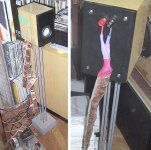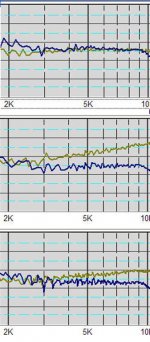The one possible exception to this would be if an undersized iron cored inductor was used. Differences at higher power levels would be quite audible if the core started to saturate. In such a case dcr would be the least of your worries. Otherwise if the inductor is air cored there are no real linearity concerns, and differences probably relate to things like the lumped capacitance across the inductor and the dc resistance of the inductor.
Long ago I worked for a speaker company in Wilmington MA that made a well respected 2 way speaker. Everyone copied this metal cased speaker. I was there as a temp in QC (Times were desperate, any job was a job) and was doing final acceptance on this particular product. The inductor in the x-over was iron cored and saturated at under 4W rms at 1kHz - this dumped a lovely looking square wave into the 4" woofer which quite happily buzzed along with the tweeter. This sounded very nasty. The inductor in question was wound on an EI shaped core and had a footprint roughly the size of a nickel. Note that 4W test power was about 10dB below the maximum power handling of the speaker so arguably on sane levels of music playback the distortion probably would not have been a problem.
Kevin
Long ago I worked for a speaker company in Wilmington MA that made a well respected 2 way speaker. Everyone copied this metal cased speaker. I was there as a temp in QC (Times were desperate, any job was a job) and was doing final acceptance on this particular product. The inductor in the x-over was iron cored and saturated at under 4W rms at 1kHz - this dumped a lovely looking square wave into the 4" woofer which quite happily buzzed along with the tweeter. This sounded very nasty. The inductor in question was wound on an EI shaped core and had a footprint roughly the size of a nickel. Note that 4W test power was about 10dB below the maximum power handling of the speaker so arguably on sane levels of music playback the distortion probably would not have been a problem.
Kevin
kevinkr said:The inductor in the x-over was iron cored and saturated at under 4W rms.....The inductor in question was wound on an EI shaped core and had a footprint roughly the size of a nickel.
Sooooo, if i use the E-I core from a 20VA tranny for a 25W crossover and the E-I from a 150VA tranny for a 100W crossover, there's no issue? That's what I gather here.
Personally I would use an air core inductor if I had the space for it, but yes perfectly good iron cored inductors do exist and it is perfectly appropriate to use them to meet cost and size targets as needed.
That said I would probably not use them in anything other than the woofer cross-over..
Kevin
That said I would probably not use them in anything other than the woofer cross-over..
Kevin
Regarding non-aircore chokes, I've personally found the silicon steel solenoid type (bar core) inductors sonically ok for values over 5-10mH in the bass, although they're not the last word in audio cleanliness. It doesn't hurt that they measure much better distortion-wise than other iron or ferrite core chokes either.
In addition to dielectric and vibrational issues mentioned above, many wire air core inductors do not mention the copper purity. The foil inductors usually use electrolytic copper, of 4 nines or better purity. I believe purity/crystal structure issues are of lesser importance, being a layer or two below the other issues.
Now, just to throw a spanner in the works, for the midrange inductor and house curve inductor, we just wound up a pair of coils from Cardas bare silver with Teflon tubing. Tedious getting the tubing on in about 3 foot lengths at a time, but we now feel that there is no going back. Clarity went up, true clarity without any added high frequency emphasis. I suspect that silver foil would be even better, but the silver wire is a bit of a stretch for the budget, and the foil is simply out of reach.
Now, just to throw a spanner in the works, for the midrange inductor and house curve inductor, we just wound up a pair of coils from Cardas bare silver with Teflon tubing. Tedious getting the tubing on in about 3 foot lengths at a time, but we now feel that there is no going back. Clarity went up, true clarity without any added high frequency emphasis. I suspect that silver foil would be even better, but the silver wire is a bit of a stretch for the budget, and the foil is simply out of reach.
After doing some measurements on FR speakers using BSC, it seems that Alpha Core Foil inductors have significantly more phase lead from the mids increasing though 10K Hz, After modifying a BSC to accomodate this, the sound improved significantly. The bass does sound a bit fat, and large excursions caused by bass makes the higher sounds tremble.
First impression using Copper foil (#14)and litz (#16) inductors in BSC circuits. Copper foil seems more live, a little more depth, and the litz one seems more balanced (like something I would expect in a recording studio). Very interesting! Hope to get some tests and see if they differ.
soongsc said:After doing some measurements on FR speakers using BSC, it seems that Alpha Core Foil inductors have significantly more phase lead from the mids increasing though 10K Hz
Could you elaborate on this a bit? Test setup, results? Thanks!
SY said:
Could you elaborate on this a bit? Test setup, results? Thanks!
2mH, 5Ohm, 6.8uF in parallel. Acoustic test far field.
1. Original design with normal air inductor on bobin.
2. Changed to #14 foil
3. Removed 6.8uF
This is as much as I can provide without getting too project specific.
Attachments
planet10 said:The copper foil inductors make interesting speaker wire (1 Jensen foil inductor, roll of packing tape, double sided carpet tape * heatshrink)
dave
How did they sound?
Anyone tried these foils before?
http://www.partsexpress.com/webpage.cfm?&DID=7&WebPage_ID=197#16gauge
I wonder how they sound. And how they compare against the ones in the first post since they are much cheaper.
http://www.partsexpress.com/webpage.cfm?&DID=7&WebPage_ID=197#16gauge
I wonder how they sound. And how they compare against the ones in the first post since they are much cheaper.
soongsc said:How did they sound?
Good. Different then my cryo Cat 5. Haven't really done a good comparison yet.
dave
=¼0?ried flat wire inductors and compared them to round wire inductors:
1. of course I used inductors with the same DC-resistance (this depends mainly on the cross section area of the wire and not on the shape...)
2. I measured the frequency response and distortion and I could not see a significant difference
3. I listened to both. I could clearly hear a difference. I agree that the purity of the material is probably more important. But also microphonie is quite a big factor. I you abuse a coil with a high power signal (without speaker) you can act hear the signal coming from the coil! There are quite big magnetic forces working on the wire, so it is important that the wire cannot vibrate. Some coils are backed with a resin and they have a much cleaner sound.
I found the flat wire sounded cleaner and the bass was more precise. But that is also a matter of taste and preference.
1. of course I used inductors with the same DC-resistance (this depends mainly on the cross section area of the wire and not on the shape...)
2. I measured the frequency response and distortion and I could not see a significant difference
3. I listened to both. I could clearly hear a difference. I agree that the purity of the material is probably more important. But also microphonie is quite a big factor. I you abuse a coil with a high power signal (without speaker) you can act hear the signal coming from the coil! There are quite big magnetic forces working on the wire, so it is important that the wire cannot vibrate. Some coils are backed with a resin and they have a much cleaner sound.
I found the flat wire sounded cleaner and the bass was more precise. But that is also a matter of taste and preference.
soongsc said:First impression using Copper foil (#14)and litz (#16) inductors in BSC circuits. Copper foil seems more live, a little more depth, and the litz one seems more balanced (like something I would expect in a recording studio). Very interesting! Hope to get some tests and see if they differ.
The Solen HepaLitz seem to generate less phase lead than the Alpha Core foil. Both sound better than the round solid core inductors. I think it would be interesting to use same guage foils and see what happens.
The more I listen to different inductors, the more confused I get. Using a BSC for a full range, using foil gives a sense of depth and a greater soudn stage, however, all performances seem a little further away, the total depth between the most front and the most rear seems a little shallow. With the plain copper wire inductor, sound stage seems smaller when you listen to the ambient sound of recordings. The total depth seems slightly deeper because the most forwrd image of some recordings come closer to the front. Even though the FR seems similar, changes in the phase response have me convinced that the plain wire indcutor should be more accurate. But yet what the real performance sounded like is unknown to us. I am beginning to feel that if the foil inductor is not in series with the high frequency driver such that the phase is changed, then the foil would be better than a plain wire inductor.
The phase is indeed intertwined with the depth of image.
The more low end you can recreate the more depth and spaciousness you gain.
My thinking is that the foils have alot of capasitance and cause the phase lead. Can you measure this? Is it more than the 6.8uF you were also using?
Single drivers also have there own phase isuess.....
The more low end you can recreate the more depth and spaciousness you gain.
My thinking is that the foils have alot of capasitance and cause the phase lead. Can you measure this? Is it more than the 6.8uF you were also using?
Single drivers also have there own phase isuess.....
Coolin said:The phase is indeed intertwined with the depth of image.
The more low end you can recreate the more depth and spaciousness you gain.
My thinking is that the foils have alot of capasitance and cause the phase lead. Can you measure this? Is it more than the 6.8uF you were also using?
Single drivers also have there own phase isuess.....
I'm almost sure that capacitance cannot be measured for just the coil because the two leads are shorted. I kind of think the phase is related with interaction between the driver. 6.8uF was used in the previous tests I made. It was determined based on specific driver characteristics, then the only thing changed was the inductor. Actually replacing the cap with an Mcap silver/oil produced the same effects of a more significant degree, but since this is a wire thread...
- Status
- This old topic is closed. If you want to reopen this topic, contact a moderator using the "Report Post" button.
- Home
- Design & Build
- Parts
- Copper foil versus wire in inductors

